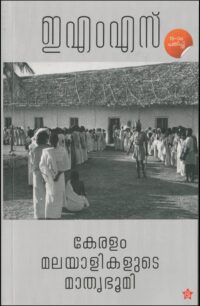Although overlooked in the current policy framework, the consequences of land reforms are significant as shown by the experience of Kerala, where a direct link can be drawn between excellent performance in key socio-economic indicators and land reforms in the second half of the twentieth century. The contribution of the first communist government of the State of Kerala, led by the Chief Minister E. M. S. Namboodiripad (or EMS) was the most significant in bringing in new legislation on land reforms. EMS was a well-known public intellectual of the Left in Kerala, who wrote extensively on Indian economy and society from a Marxist perspective. This blog provides a few illustrations of how land reforms have transformed villages in central Kerala, beginning from EMS’s observation of wealth inequality in a village in the 1930s.
In his work Keralam: Malayalikalude Mathrubhumi (Kerala: The Motherland of Malayalis), published in 1948 and updated in later years, EMS documents the distribution of wealth across different caste groups in Anthikad (Anthicad in Census records), a village in Thrissur district in central Kerala (pages 150–151 in the Malayalam book; an updated English version of the book titled Kerala, Society and Politics: An Historical Survey is available here). The analysis is based on the value of property held by households, from a special study conducted by the Government of Cochin in the 1930s (Reports on the Economic Survey of Selected Villages were published in 1936).
According to the village study, the value of property (of which land was the main constituent) held by different households showed extreme inequality across caste groups. The value of property was Rs 30,593 per household for a Namboodiri (Brahmin) household. There were only three Namboodiri households in Anthikad village. It was Rs 10,848 per household for other Caste Hindus. At the other end of the distribution, a Pulaya caste (Scheduled Caste or SC) household owned property worth only thirteen rupees. In other words, the average Namboodiri household held nearly 2500 times the average wealth owned by a Pulaya household in the village.
EMS estimated that redistributing total wealth in the village to all households equally (i.e. taking a simple average) would result in each household having property valued at Rs 1,488. These data clearly establish the appalling concentration of wealth in the hands of a few in the early part of the twentieth century These data also show the social reality of Kerala prior to land reforms: Scheduled Caste households, who were largely agricultural labourers, were landless and held a miniscule amount of wealth (land). There is much scholarly writing on various forms of caste oppression that existed in Kerala during this period, in combination with the highly unequal economic structure (such as here and here).
Land Reforms and Social Change
Kerala’s society underwent tremendous change as a result of land reforms and the working-class movement. Lands reforms in Kerala, initiated in the 1950s and largely completed by the end of 1970s, had three components: conferring ownership rights of agricultural lands to tenants, redistribution of ceiling-surplus lands, and providing ownership rights of homestead lands to agricultural workers. The first and third aspects of land reforms were near complete. The second aspect, involving redistribution of ceiling-surplus lands, was judged to have a very limited impact. Notwithstanding this limitation, the most striking success of land reforms, and the organised struggles for the implementation of land reforms led by the Left, was the destruction of landlord’s dominance of social life in the villages of Kerala.
What happened to Anthikad village after the land reforms? We have data from a recent study conducted by G. K. Rajendran in 1996 as part of the Kerala Research Programme on Local Level Development at the Centre for Development Studies (CDS). After the study in the 1930s, the village was studied again by the Census of India in 1961. Rajendran noted that “in 1961, 63 per cent of households did not own land, but today there is no landless household in the village. Most of the households owned land between 50-100 cents.” Along with the changes in economic structure, he also noted changes in cropping pattern and land use, improvements in infrastructure, and increased migration within the village. Although the article I reviewed do not provide precise details on how educational levels have changed over times, the author notes that “people in the village have made use of the educational opportunities and the village has a high percentage of the labour force with high educational attainments.”
This enormous change to the standard of life subsequent to land reforms has been noted by several scholars across Kerala. Although broad changes in land holding pattern are available for Kerala across time, a detailed district- or region-wise comparison is not available, and scholars have largely focused on village studies to examine various aspects of change before and after land reforms (eg. here, here, and here).
How widespread were the land reforms? For Kerala as a whole, “around 2.8 million tenants were conferred owner-ship rights (or had their rights protected),” that covered about 0.6 million hectares between 1957 and 1993 (Appu 1996, as cited here). Only 1.47 per cent of the total operated area was redistributed as ceiling-surplus in this period. The component of land reforms that directly benefited landless agricultural workers was the issuing of homestead ownership certificates, which was received by around 528,000 households between 1957 and 1996 (ibid.). North Kerala (Malabar region) had a larger concentration of tenants across all regions of Kerala and the effect of land reforms was more substantial there. But the reforms were not limited to that region, as other parts of Kerala such as central Kerala, also saw changes in relation to agricultural and homestead land ownership. However, there have been only a few studies that examine land reforms in central Kerala.
Continuing Effects in the Twenty-first Century
The effect of land reforms in Kerala can be seen even today. I studied Adat village panchayat in Thrissur district, about 20 km from Anthikad, as part of my doctoral research. This village panchayat is similar to Anthikad village in terms of the overall agro-ecological context, as both areas fall in the kole wetland region. Drawing on my insights from a detailed survey of 65 households conducted in 2018-19, I report here on some of findings related to distribution of land and other aspects of wealth from a sample of rice-cultivating households.
First, Scheduled Caste (SC) respondents in my sample reported receiving land as part of land reforms in Adat village panchayat. My sample had eight SC households, belonging to Pulaya (5 households), Panan (1), and Vettuva (2) castes. The area of homestead land is small, with an average of 7 cents and holding size ranging from 3 to 16 cents, but no household is landless today (one cent is equal to one-hundredth of an acre or 0.0247 hectare).
Secondly, all SC households except one owned rice-cultivating agricultural lands (the major agricultural crop in this village panchayat is rice). For the seven households, the extent of this land ranged from 25 to 177 cents and the average for all eight households was 78 cents. Some of this land was land purchased through a programme initiated by the Scheduled Caste Development Corporation (of Kerala) in the 1990s and 2000s. All SC households in my sample engaged in rice cultivation (the one household without ownership holding leased-in agricultural land for rice cultivation). Income from rice cultivation contributed to around 11 per cent of their average household income (computed by aggregating incomes from 10 sources). The income from rice production was on an average the third largest source of income for these households (the first and second being income from salaries in private sector, and wages from non-agricultural work respectively).
Thirdly, most of the younger members of these households had completed tertiary education and were diversifying into occupations other than farming or agricultural labour. My sample had 12 persons between the age group of 18 and 35 years. Their median years of schooling was 14.5 years. For those aged above 60 (6 persons), it was 3.5 years and for persons between 36 and 59 years (16 persons), the median years of schooling was 10 years.
Even while we see progress across generations within SC households, there is still a gap between SC households and households from other castes in terms of incomes and land and non-land asset ownership. With respect to incomes, the average income of SC households was around 60 per cent of average household income of OBC and other households. In terms of homestead land, the average land owned by Other Backward Class (OBC) households (23 households) was 29 cents and others (34 households) was 39 cents. It ranged from 7 to 105 cents and 3 to 220 cents for these two groups respectively. In terms of rice-cultivating lands, the OBC households owned an average of 157 cents and others 351 cents. The range was 25 to 575 cents and 17 to 1639 cents respectively.
To a large extent, houses of the SC households were not located in the central area of the village. Their houses were smaller in comparison. The median area of SC houses was 650 square feet (around 60.5 sq. m.), whereas it was 1050 square feet (around 97.6 sq. m.) for OBCs and others. The SC households were less likely to own cars, motorcycles, or other durable goods compared to OBC or others.
Concluding Remarks
The conditions in rural Kerala today are very different from what they were before land reforms. The act of providing ownership rights to house sites to landless households, most of whom belonged to the Scheduled Castes, reduced inequality and improved living conditions in villages of Kerala. This aspect of land reforms had subsequently paved the way for social mobility. The experiences of land reforms from across the world and India, also point to the fact that a radical change in land relations (or the absence of it) has led to wide-ranging changes in various societies (some discussions and related studies can be seen here, here, and here).
The changes in Kerala seem particularly remarkable when we compare it with places that did not see even such a change. The recent study on Bihar’s homestead landlessness presents a case where such effects did not occur due to want of land reforms. In the villages of Bihar, manual worker households do not own their house sites and “the risk of eviction by the landowner is a source of extra-economic coercion that greatly increases the vulnerability of the worker in the labour market.” In contrast, ownership of homesteads has freed many in Kerala to pursue better economic opportunities. Even with limitations, the lasting effects of land reforms in Kerala show the effectiveness of such policies in securing rights of the oppressed castes and providing economic wellbeing to the marginalised, a lesson that is still relevant in contemporary India.
About the author
Deepak Johnson is a JSPS Postdoctoral Researcher at the Institute of Economic Research, Hitotsubashi University.


















































 Sudha is an Administrative Assistant of the Foundation. She assists the administrative division of the Foundation and also has taken part in fieldwork organised by the Foundation.
Sudha is an Administrative Assistant of the Foundation. She assists the administrative division of the Foundation and also has taken part in fieldwork organised by the Foundation.












